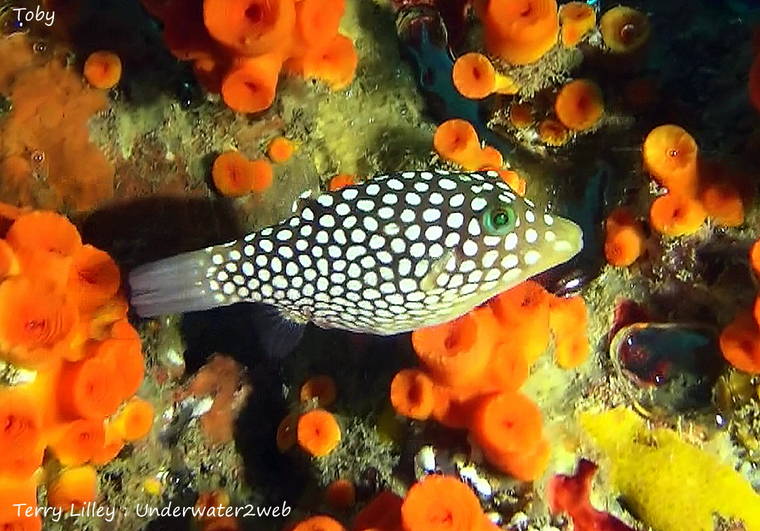This fish is a true Hawaiian local endemic species, as it lives nowhere else in the world but the Hawaiian Islands. They are very common on almost all Hawaiian reefs, from silty bays, coral reefs and even in caves under the reef.
The toby only grows to about four inches long, and it is often mistaken for a female boxfish (moa) that has the same colors and pattern, but the toby has a pointed snout and is a sharpnose pufferfish.
You usually see tobies in pairs, and they are quite territorial. They will often bite the fins of much larger fish, scaring them away, and they will come right up to us divers with little concern.
If you were to grab a toby it would fill up with water and puff up to twice its normal size. This helps it from being eaten by predators. Like most of the pufferfish the toby has toxins in its skin that are poisonous to some fish species and humans. Even the Hawaiians never ate the tobies, and more then likely did not even pay attention to them, as there is not even a Hawaiian name for this fish that we know of.
Tobies feed on algae and sponges, so you will see them picking at the reef or feeding in caves with their small, pointed mouths. When they are feeding in a dark cave where the sponges grow they will swim upside down looking for food on the roof of the cave. But when they come back out into the sunlight they swim right side up. Like all pufferfish they have thick skin and a ridged body, and their fins can be used so they can go in any direction at will, and will dart into cracks in the reef quickly if alarmed.
Tobies often look like they are pregnant, as they have a fat extended bellies. This actually is caused by nematode worms that often grow inside of them. Some tobies will also have large, black blotches on their skin and fins. We think that is a reaction to coming in contact with cyanobacteria that grows on the reef and can cause coral and fish diseases.
Both male and female tobies look the same, and are often seen together during the day. But at night they separate and sleep by themselves right on top of the exposed reef.
You can see the toby in action up on the underwater educational web page, www.underwater2web.com, and in the movie “The World’s Guide to Hawaiian Reef Fish.” Youngsters can visit the tobies in person this summer at the nonprofit Coral Reef Kids Camp. Get more information at reefguardianshawaii.org.
•••
Terry Lilley is a Hanalei resident and avid diver who writes a weekly column for The Garden Island.





